‘The End of Transition: Shifting Focus’ Takes Place at USC
LOS ANGELES, Calif.—To mark a quarter century of transition beginning with the Soviet collapse in 1991, the University of Southern California (USC) Institute of Armenian Studies held a two-day conference on April 9-10. Entitled “The End of Transition: Shifting Focus,” the Institute hosted scholars and specialists from across the globe as they discussed Armenia’s trajectory since it established independence in 1991.

(L to R) Professor Robert English, Amberin Zaman, Vartan Oskanian, and Dr. Hans Gutbrod
Salpi Ghazarian, the director of the Institute, kicked off the conference on April 9, with an introduction and welcome.
“We don’t see where the post-Soviet space is heading,” she said. “The people who care are the people of Armenia and the people of the Caucasus. They gave up the predictability and stability that were the hallmarks of the Soviet Union. And they did that in exchange for what? That’s what we want to know and frankly, that’s what we’re going to be asking these next two days.”
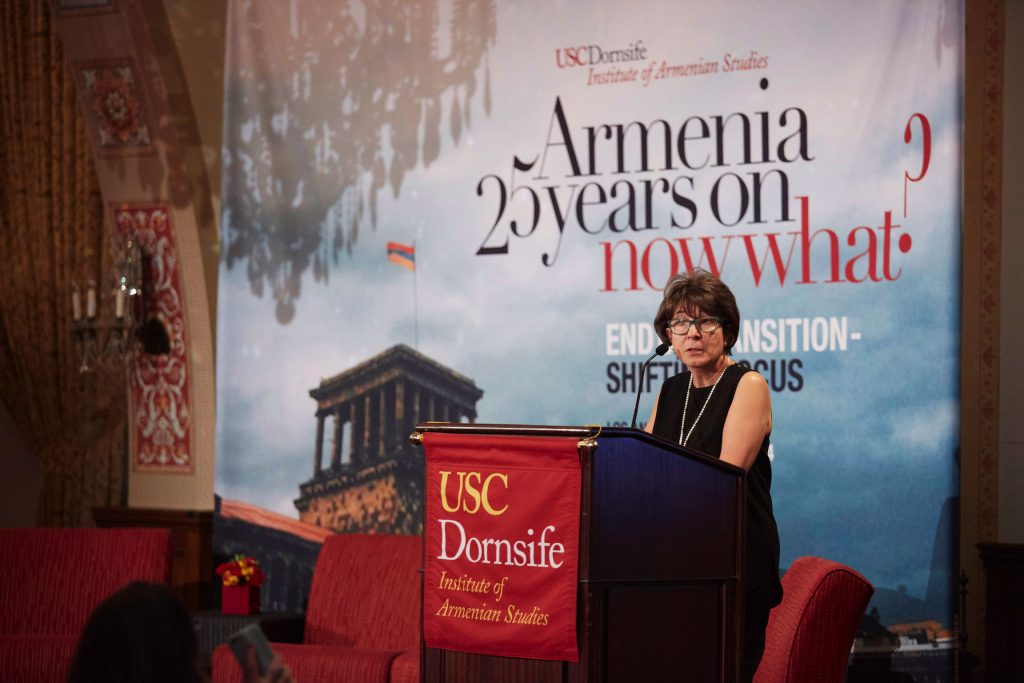
Salpi Ghazarian
The two-day Los Angeles conference is the first leg of what is planned as a two-city event. The conference will continue in Yerevan on May 23-24, with additional scholars and practitioners looking back over a quarter century, and looking forward to answer the question – Now What? This question was especially appropriate as the April 9 conference came just a week after Armenia’s parliamentary election.
The first day of the conference was moderated by Dr. Robert English, Deputy Director of the USC School of International Relations.
Professor English introduced the first speaker, Jack Matlock, the last U.S. ambassador to the USSR. Matlock served between 1987 and 1991. Matlock will be present at the Yerevan conference as well. In Los Angeles, he spoke by video.
“Matlock is certainly one of America’s most distinguished diplomats, in the tradition that stretches from Benjamin Franklin to George Kennan,” English said. “He not only represented his country with extraordinary skill, but played a vital personal role in the world-changing transformation that was the Cold War’s end.”
Ambassador Matlock and English discussed the U.S. Embassy’s perspective on the various conflicts that emerged in the South Caucuses toward the late 1980s, tensions between Azerbaijan and Armenia over Karabagh, and turmoil in Georgia.
“I can’t say there was a U.S. policy because basically these were things that the Soviet Union had to deal with,” Matlock said. “Our own foreign policy could only go so far, but we did try to explain to Washington what the problems were.”
Both Armenian and Azerbaijani Communist Party First Secretaries had conveyed their growing concerns to the ambassador.
“They frankly were in despair,” Matlock said. “Both of them said, ‘We can’t solve this.’”
With rising pressure from their home countries, the secretaries relied on Moscow to pose a solution; however, Matlock stated that Mikhail Gorbachev, the General Secretary of the Soviet Union at the time, extended very little effort toward resolving the issue.
“Gorbachev was not willing to take a more active role,” he said. “It was against his principle of not applying force to these things.”
While Azerbaijanis and Armenians engaged in clashes, Georgia was experiencing what President George Bush called “suicidal nationalism,” which Matlock said referenced Georgia’s frictions with South Ossetia.
Matlock noted that, as long as Russia continues to sense growing hostility from Baku, and Russian attitudes toward ethnic Azerbaijanis remain negative, it will lean toward favoring Armenia; however, his assessment also concluded that Russia would encourage inter-fighting between the two countries, in addition to Georgia, if it felt all three states were exhibiting anti-Russian sentiments.
“Any rational Russian leader would like to have close relations with all three,” he said.
Following Matlock, English introduced Amberin Zaman, a journalist formerly with the Economist, now with Al-Monitor, and analyst with the Woodrow Wilson Center, to speak about regional relations, with a focus on Turkey. Zaman summarized relations during the transitional period – between Turkey and Armenia, between Turkey and Russia, and with the West.
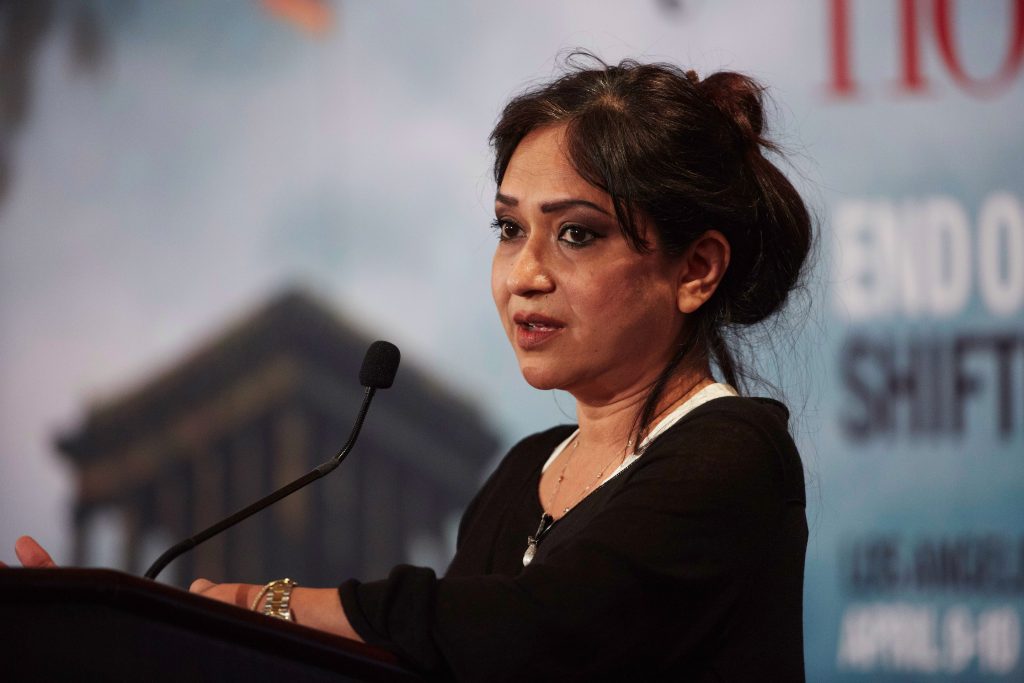
Amberin Zaman
In the wake of the U.S. missile strike on Syria, Zaman concluded that Russia’s and Turkey’s opposing interests in Syria, with the latter openly pushing for regime change and the former continuing to back Assad’s government, would impact Armenia. Due to the fluctuating relations between the two countries, Armenia’s own potential for improved relations with Turkey may be adversely effected to the Turkey-Russia standoff.
Following Zaman, former Foreign Minister of Armenia, Vartan Oskanian, discussed Armenia’s foreign policy choices, the current situation in the Caucasus, and the early years of Armenia’s independence.
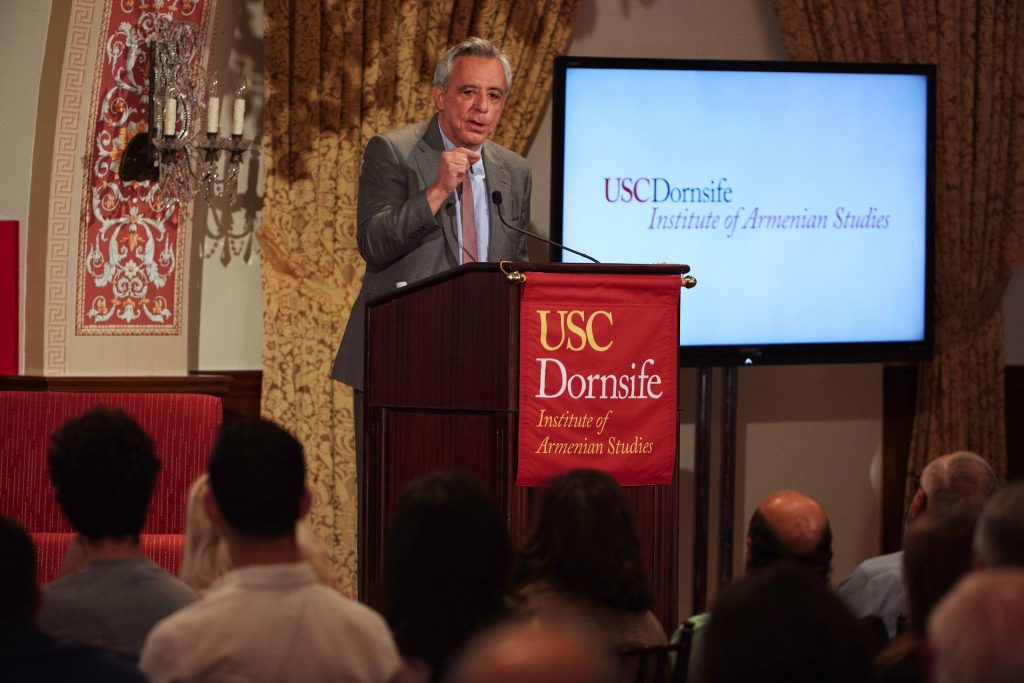
Vartan Oskanian
“The Caucasus is among the world’s most divided and incoherent regions,” Oskanian said. “Its constituent republics — Armenia, Azerbaijan and Georgia — basically failed to learn from similarly grouped countries, like the Benelux countries or the Baltic states, which, despite their historical grievances and political differences, came together and worked together to achieve their common goals of stability, prosperity, and democracy.”
According to Oskanian, such a vision was not impossible when the three Caucasus countries became independent, noting that when the Russian Empire collapsed during World War I, the three became part of a short-lived confederation before going their separate ways and being absorbed into the Soviet Union. When the Soviet Union collapsed in 1991, similar ideas of confederation emerged in the region, though such outcomes were never realized.
“What divides these three countries in the Caucasus is not religion, culture, history or tradition,” Oskanian said. “It is the differing visions, prospects, convictions and aspirations that each one of these countries espouses and pursues.”
Comparing the unstable political systems and oligarchic economies to countries in the North Africa region, Oskanian said Georgia is the most democratic among the three nations. Georgians’ ability to change governments twice following independence empowered the populace, while Armenians in comparison, despite several attempts, were unable to bring change. In Azerbaijan, which remains dynastic, no such attempts have even been made.
The contrasting directions in democracy, institutions and political processes have led to what Oskanian called “dangerously divisive” and different foreign policy approaches. For example, Georgia signed with the European Union, suggesting serious future institutional changes to meet EU standards, while Armenia joined the Russian-led Eurasian Union. Azerbaijan is part of neither.
MIT Professor Daron A?emoglu followed up with a discussion entitled “Why (Some) Nations Fail,” focusing on obstacles to economic development. A?emoglu’s assessment stipulated that the Armenian Diaspora served as a bridge for Armenia and the Western World, passing along ideas for democratic models and market-driven economies. However, A?emoglu said that this bridge ultimately did not work, citing complex factors.
“At a very high level, I think the biggest issue is that, in the transition economies where the former communist elites were totally cast aside, transition worked better,” he said. “In places like Russia, Uzbekistan or Kazakhstan, where the communist elites control the process, things work really badly. In Armenia, I think unfortunately we are much closer to the second type of transition and we have paid the price.”
Sunday’s final speaker was Dr. Hans Gutbrod, director of Transparify, a policy research and advocacy organization based in Tbilisi, Georgia.

Dr. Hans Gutbrod
Gutbrod’s presentation focused on the transition away from “a transition paradigm” and what that means for activism and “people who want to change things.” Gutbrod said he hopes to appeal to different audiences: those with academic interests, but also activists and youth who want to contribute.
During his time running the Caucasus Research Resource Centers in Armenia, Georgia, and Azerbaijan, he observed the different transitional periods of the three nations in the post-Soviet space. While Georgia experienced some successful governmental change, Armenia remained stagnant post independence and Azerbaijan transgressed despite abundant economic resources.
While some former Soviet states have undergone successful democratic, infrastructural and economic transitions, the countries of the South Caucasus have had more difficulty, particularly in terms of civil society. The concept of a content middle class has also failed to materialize successfully. In Armenia, surveys show that 28 to 30 percent of citizens aged 18 or above said they would leave the country and never go back.
“Rather than having a content middle class citizen, we have people that dream of going abroad and that are apathetic about the extent to which they can change, and all of this at this point risks getting worse,” Gutbrod said.
The Sunday discussions concluded with a conversation among English, Zaman, Oskanian, and Gutbrod.
The conference continued on April 10.
The first panel—on Foreign Policy and Regional Integration—was chaired by Professor English. Dr. Laurence Broers from the Royal Institute of International Affairs in the United Kingdom started the panel off by discussing the period of violence that erupted in 1998 and ended in a ceasefire between Azerbaijan and Armenia in 1994. He specifically honed in on the communal violence that occurred along ethnic lines among Armenians and Azerbaijanis. “In the case of anti-Azerbaijani violence in Armenia, I argue that a very different emotional disposition was at play with a deep cultural schema prescribing innate historically framed roles to difference groups providing an explanation. That cultural schema was genocide. The pogrom in Sumgait and all subsequent outbreaks of anti-Armenian violence in Azerbaijan and even local incidents in Armenia such as the outbreak of a disease were merged into a unified narrative of serial genocide,” explained Broers in trying to understand how the conflict and perceptions of the conflict were transformed in the early years.
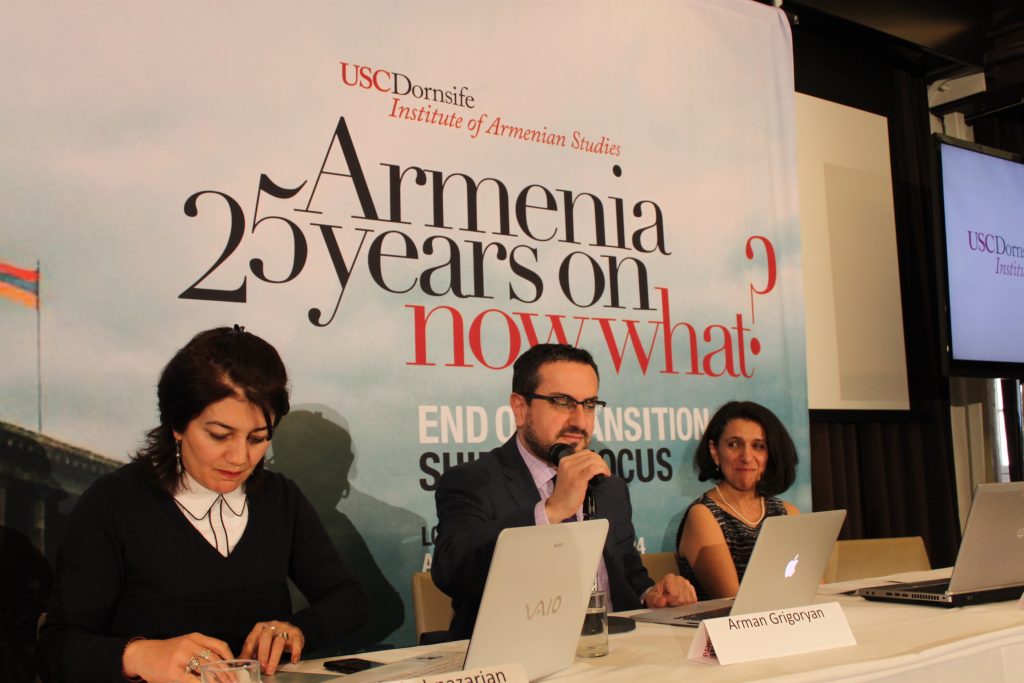
(L to R) Dr. Nona Shahnazarian, Professor Arman Grigoryan, and Professor Anna Ohanyan
The Karabagh topic continued in a presentation by Emil Sanamyan, an independent analyst who specializes in the Karabagh conflict, and edits “Focus on Karabagh” on the USC Institute of Armenian Studies website. Sanamyan’s talk was called “Who is Fighting and Who is Dying in Karabagh.” He pointed to a map and explained: “This is an interesting map that somebody from Azerbaijan prepared. It shows the birth places of soldiers killed in the April 2016 War. You see that it is fairly spread out, one area that is sort of missing is Baku. There were no casualties from the city of Baku. And Baku represents roughly one-fourth of Azerbaijan’s population. There were some kids, mostly conscripts, from villages around Baku but not from Baku itself. On the Armenian side, the situation is slightly more egalitarian. Yerevan represents a substantial number of casualties, both amongst the regular army and the volunteers but a majority are still from rural areas; so this is a socio-economic breakdown of casualties.”
Gregory Aftandlian addressed American foreign policy’s diminishing interest in Armenia. He explained that foreign policy is based on ideas and interests. The idea of democracy and liberalization is important to the US, but not being followed by Armenia; and the US oil interests provide reason for it to veer towards Azerbaijan. “Since the early 1990s, US government aid to Armenia is about 2 billion dollars overall. This has been on a downward slope. Today assistance level is about $11 or $12 million while in some years it was something like $120 million.”
Dr. Phil Gamaghelyan traced the evolution of thinking and feeling among groups of Armenian and Turkish students living in the US and interacting over periods of time to come to understand the other’s sense of history. This effort at people-to-people interaction to begin to come to a reciprocal understanding of each other’s perceptions of history resulted in a variety of new questions about each side’s own understanding of its own history.
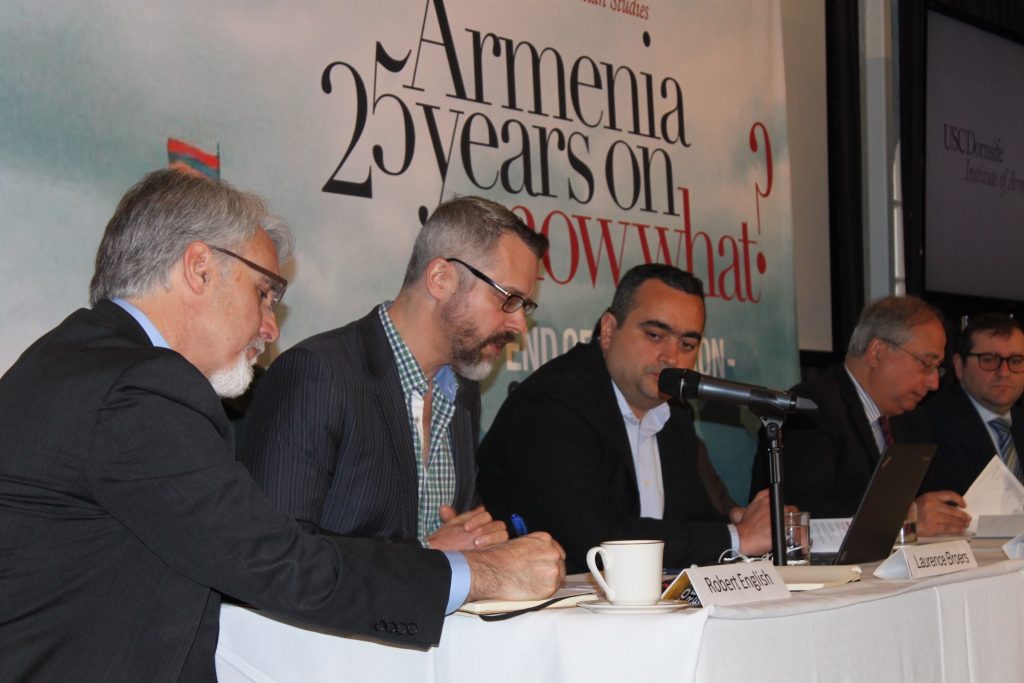
(L to R) Professor Robert English, Dr. Laurence Broers, Emil Sanamyan, Gregory Aftandilian, and Dr. Hrant Kostanyan
Dr. Hrant Kostanyan, with the Centre for European Policy Studies spoke about the missed opportunities for European Union – Armenian rapprochement during the transition years. He concluded that the EU had been unable to fulfill Armenia’s serious security needs, while Armenia’s elites and institutions were unable or unwilling to adapt to (or benefit from) the EU’s stringent safety and quality standards for trade. This, despite the fact that the EU is Armenia’s largest trading partner.
In between discussions of foreign policy and internal governance, the conference audience enjoyed a presentation by Eric Nazarian, a filmmaker, and a Fellow of the USC Institute of Armenian Studies. Nazarian provided a quick overview of Armenian cinema in transition. “I always think of Janis Joplin, in this notion of freedom,” he said. ‘Freedom is just another word for nothing left to lose’. Of the losses that were incurred during the period of independence, there was one positive aspect of the incredible depression of the film industry in the early 1990s: censorship disappeared. Also, come the end of the 1990’s and the early 2000’s, the democratization of technology – from film to digital, really cut costs of film production by leaps and bounds. Hence you had the old generation of dogma and a whole new generation of filmmakers, and student filmmakers who were starting to experiment with film grammar.”

Eric Nazarian
The second panel—on Governance and Economics—was moderated by Dr. Hans Gutbrod.
The first speaker was Garik Hayrapetyan, who heads the UNFPA (Fund for Population Activities) in Armenia. Hayrapetyan presented an overview of the transition through stark demographic indicators. “There have been powerful shifts in demographic issues in Armenia in three areas: migration, aging, and fertility. Of these, migration is the strongest driver. Overall, we have lost 1.5 million Armenians to emigration from 1988 to 2016.”
He continued, “Armenia is exhibiting 1000 births less per year now. According to our projections, only 26,392 births will be registered in 2026. This is significant because this is already becoming an issue of national security. Finally, by 2050, Armenia’s 65+ population will rise to 22-24% of the population from its current percentage of 10.7%. This is very important for social policy. “
Hayrapetyan explained that “the decreasing birthrate is not just a reaction to the socio-economic situation, it is also due to changes of gender roles and of work-life balance.” Hayrapetyan also referred to the dangerous trend of sex selective abortions, with Armenia having the third highest rate after China and Azerbaijan. “According to our projections, by 2060, there will be 93,000 girls lost, not born. This means future mothers. That means that Armenia’s maternal base will decrease by almost 100,000. That is equal to total births in Armenia for two and a half years,” he concluded.
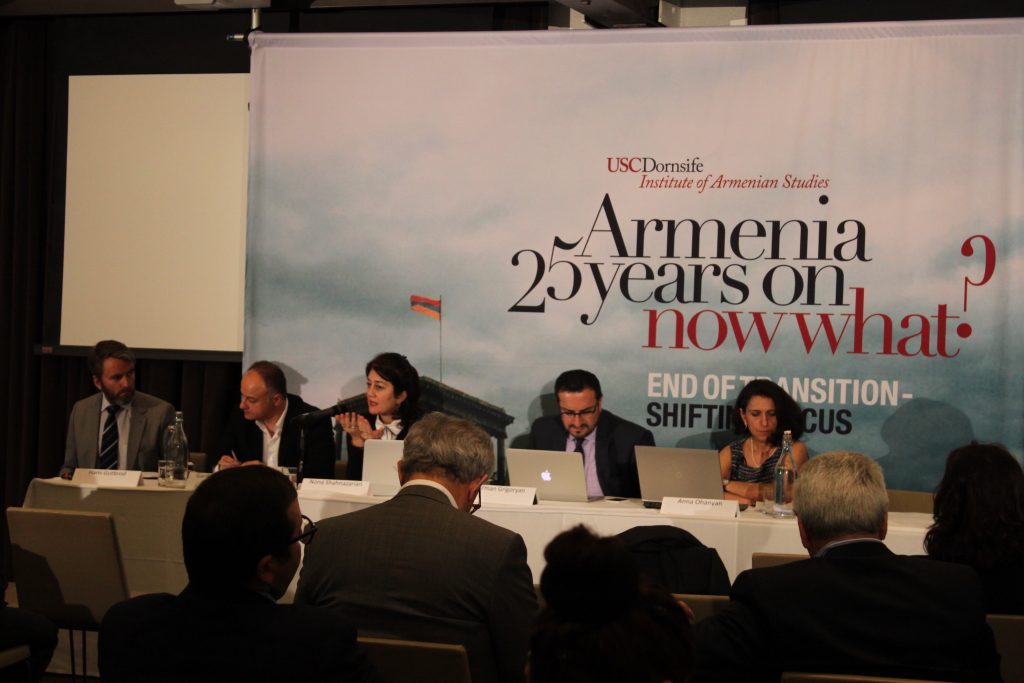
(L to R) Dr. Hans Gutbrod, Garik Hayrapetyan, Dr. Nona Shahnazarian, Professor Arman Grigoryan, and Professor Anna Ohanyan
Nona Shahnazarian, a social anthropologist, spoke about Armenians in Azerbaijan losing not only their formal financial savings, but also informal investments and social capital, as demonstrated by gifts and ‘investments’ in funerals and weddings – giving and receiving money from friends and neighbors.
Arman Grigoryan, who teaches at LeHigh University in Pennsylvania, presented the argument that Armenia’s unresolved conflict with Azerbaijan is the fundamental impediment to democratization. “Armenia is one of the most militarized nations in the world. Wars and bad security environments are bad for democracy because they create vested interests in belligerence and war. They create elites who are not suffering from the status quo. They have the power to deter internal challengers and they control the marketplace of ideas,” he said.
Professor Anna Ohanyan of Stonehill College in Massachusetts spoke about a fractured region. “The South Caucasus inherited a system of very poor regional structures of engagement. Regional fracture differs from ‘divide-and-rule’ policies because it can be a lever as well as a liability to bigger powers. As colonial legacies, they’re often deployed by neo-imperial powers, but the opposite is also true. Fractured regions can also constrain and challenge these very same neo-imperial powers, especially those seeking to adjust to the changing world. Just reflecting on Armenia’s current choices, being pooled in the Eurasian Economic Union, which many analysts are critical of, in terms of its overdependence on Russia that it is going to create. An uncritical engagement with that regional bloc, creates the danger of history repeating itself,” Ohanyan said.
Ohanyan moderated the day’s (and the conference’s) final panel.
Dr. Karena Avedissian discussed changes in the Armenian public’s perceptions and attitudes. With access to interviews conducted by Professor Donald E. Miller and Lorna Touryan Miller in Armenia in 1993 and 1994, Avedissian conducted her own set of interviews in 2015 for a comparative analysis of perceptions between the early days of independence and the present.
“What emerged was a clear change in people’s attitudes toward public issues,” Avedissian said. Earlier, more philosophic and tolerant attitudes were replaced by pessimism and general hopelessness.
Dr. Ara Sanjian, of the Armenian Studies Center at the University of Michigan, Dearborn, did a brief content analysis of the 2012 edition of the Armenian history textbook used at Yerevan State University. “The scope of topics it covers continues to remain less encompassing than that of its Soviet era antecedents,” Sanjian said. He pointed out uneven coverage of the accomplishments of various Soviet-era leaders, a heavy focus on the genocide, and minimal concentration on the independence period and the present.
Serouj Aprahamian, a doctoral candidate at York University in Canada, examined societal change through unifying artistic expressions like breakdancing. In 2005, Aprahamian only came across three dance crews with roughly 50 dancers. “It was a very limited, kind of underground and secluded thing,” he said.
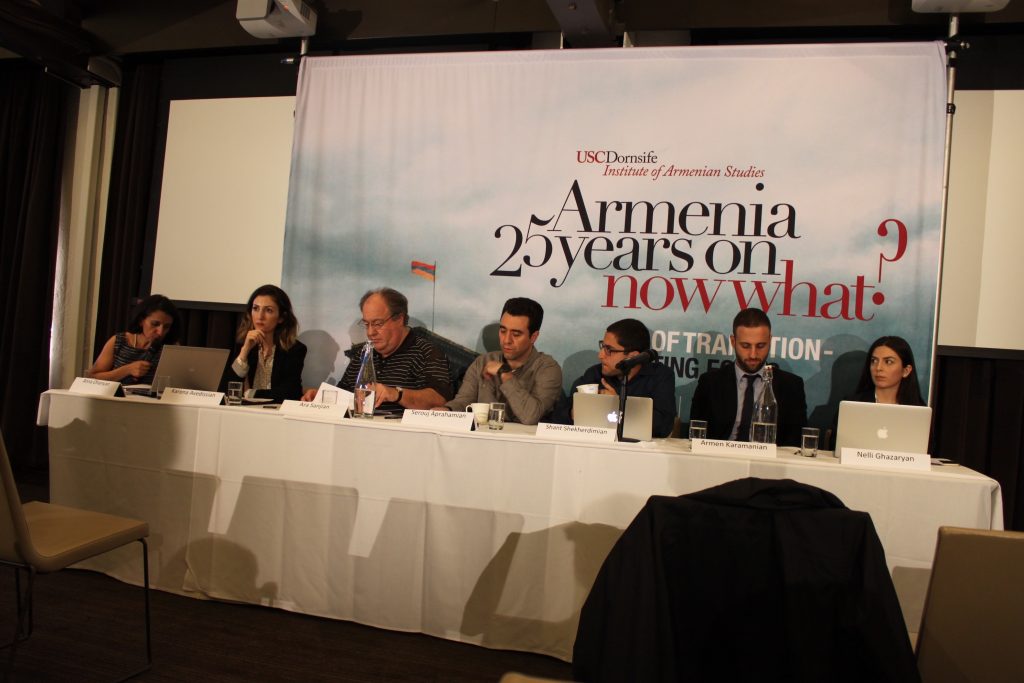
(L to R) Professor Anna Ohanyan, Dr. Karena Avedissian, Professor Ara Sanjian, Serouj Aprahamian, Shant Shekherdimian, Armen Karamanian, Nelli Ghazaryan
A decade later, however, Armenia now has fifteen crews with more than 500 breakers who engage in various events with dancers who visit from different countries, including Finland and Russia. He concluded that this unusual form of self-expression is in line with young people’s search for a new identity in the post-independence era.
Dr. Shant Shekherdimian, a pediatric surgeon, presented an analysis of the nature of Diaspora input into Armenia’s health care system. Despite sizable humanitarian efforts, Shekherdimian said the diaspora has not contributed to long-term, cost-effective, sustainable improvement of the medical care system in Armenia, resulting in increased emigration even by those who benefit from short-term intervention but worry about its long-term availability.
Armen Karamanian, of Macquarie Univeristy in Australia, asked whether it’s possible to maintain a Western Armenian identity in ‘Eastern’ Armenia. “The independence of Armenia sparked the much desired reunion between homeland and the diaspora,” Karamanian said. “Twenty-five years have passed, transition is over and institutions such as Birthright Armenia and government programs have capitalized on the diaspora’s longing to return in order to secure the development of the Armenian nation through the volunteer return of its global diaspora.”
Karamanian said that the desire to return amongst members of the diaspora is rooted in the desire to live in what remains of the ancestral homeland, despite differences in the Western and Eastern Armenian identities. However, Karamanian pointed to the integration of Western Armenian dialect as examples of “a shifting homeland attitude and inter-acceptance of variations of Armenianness, largely due to the arrival of thousands of Syrian Armenians.”
The final panelist, Nelli Ghazaryan spoke about the state of the Armenian healthcare infrastructure and compared efforts by Georgia, Armenia and Belarus to improve their healthcare infrastructure after the collapse of the Soviet Union.
Despite their shared Soviet history, the three countries have travelled down different pathways in terms of healthcare infrastructure. Armenia experienced de-centralization in its health care system, while Belarus maintained a central, government-run system. Georgia, however, experienced huge privatization. As a result, Ghazaryan found that while Armenia and Georgia lack strong public health systems, Belarus maintained the same system of public health that the Soviet Union had, in addition to incorporating patient advocacy efforts and systems that promoted wellness.
“What this conference demonstrated is that there is a demand for solid, detailed research on the specific aspects of issues facing the Republic of Armenia and the Diaspora. It also demonstrated that there is in fact a supply of scholars eager to delve into the most complicated questions. The Institute of Armenian Studies is committed to continuing to make this scholarship accessible,” said Salpi Ghazarian, at the conclusion of the conference.
Video of the two-day conference is available below.
The conference will continue in Yerevan on May 23 and 24.
‘The End of Transition: Shifting Focus’ Takes Place at USC LOS ANGELES, Calif.—To mark a quarter century of transition beginning with the Soviet collapse in 1991, the University of Southern California (USC) Institute of Armenian Studies held a two-day conference on April 9-10. Entitled “The End of Transition: Shifting Focus,” the Institute hosted scholars and specialists from across the globe as they discussed Armenia’s trajectory since it established independence in 1991. (L to R) Professor Robert English, Amberin Zaman, Vartan Oskanian, and Dr. Hans Gutbrod Salpi Ghazarian, the director of the Institute, kicked off the conference on April 9, with an introduction and welcome. “We don’t see where the post-Soviet space is heading,” she said. “The people who care are the people of Armenia and the people of the Caucasus. They gave up the predictability and stability that were the hallmarks of the Soviet Union. And they did that in exchange for what? That’s what we want to know and frankly, that’s what we’re going to be asking these next two days.” Salpi Ghazarian The two-day Los Angeles conference is the first leg of what is planned as a two-city event. The conference will continue in Yerevan on May 23-24, [...]
‘The End of Transition: Shifting Focus’ Takes Place at USC LOS ANGELES, Calif.—To mark a quarter century of transition beginning with the Soviet collapse in 1991, the University of Southern California (USC) Institute of Armenian Studies held a two-day conference on April 9-10. Entitled “The End of Transition: Shifting Focus,” the Institute hosted scholars and specialists from across the globe as they discussed Armenia’s trajectory since it established independence in 1991. (L to R) Professor Robert English, Amberin Zaman, Vartan Oskanian, and Dr. Hans Gutbrod Salpi Ghazarian, the director of the Institute, kicked off the conference on April 9, with an introduction and welcome. “We don’t see where the post-Soviet space is heading,” she said. “The people who care are the people of Armenia and the people of the Caucasus. They gave up the predictability and stability that were the hallmarks of the Soviet Union. And they did that in exchange for what? That’s what we want to know and frankly, that’s what we’re going to be asking these next two days.” Salpi Ghazarian The two-day Los Angeles conference is the first leg of what is planned as a two-city event. The conference will continue in Yerevan on May 23-24, [...]
[img][/img]
More...